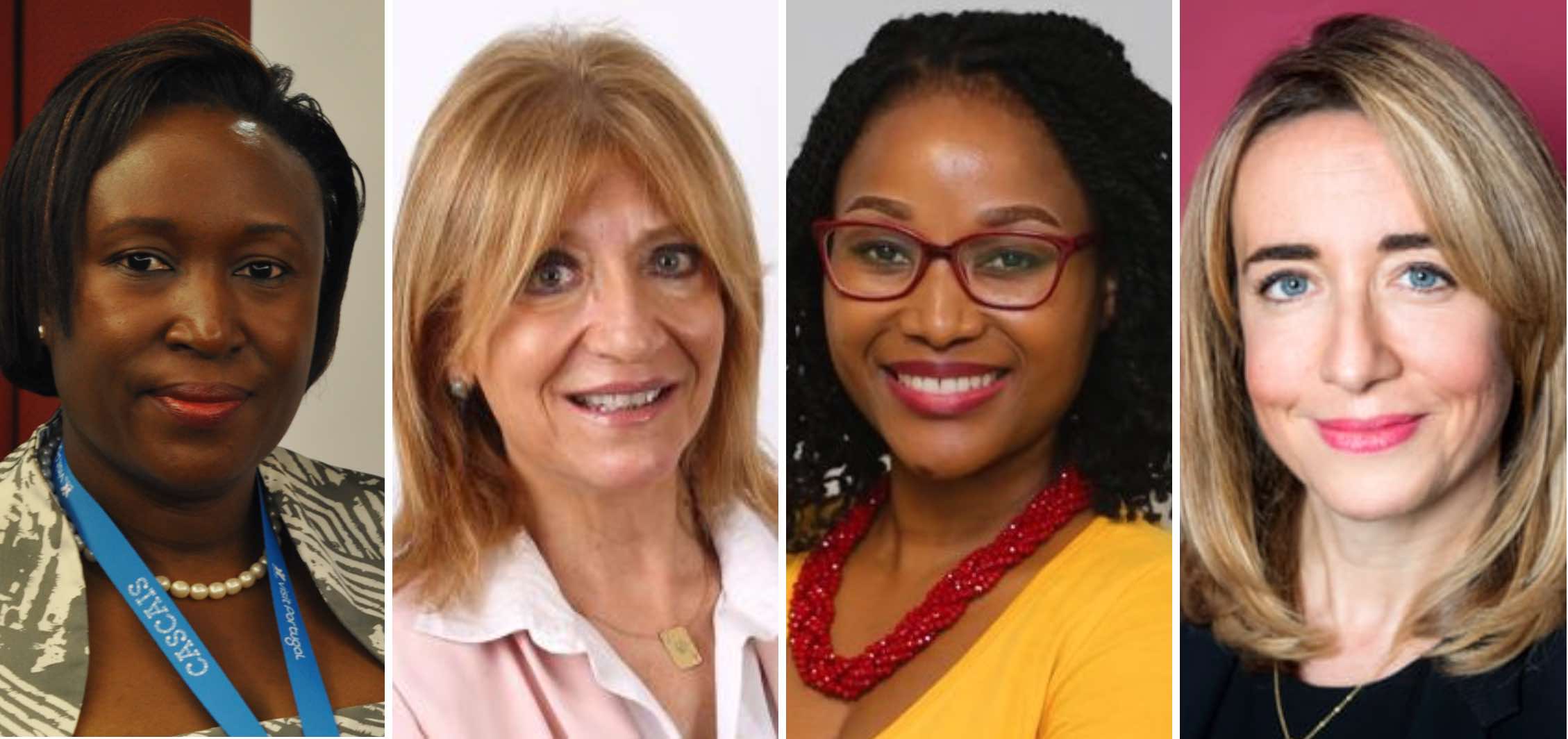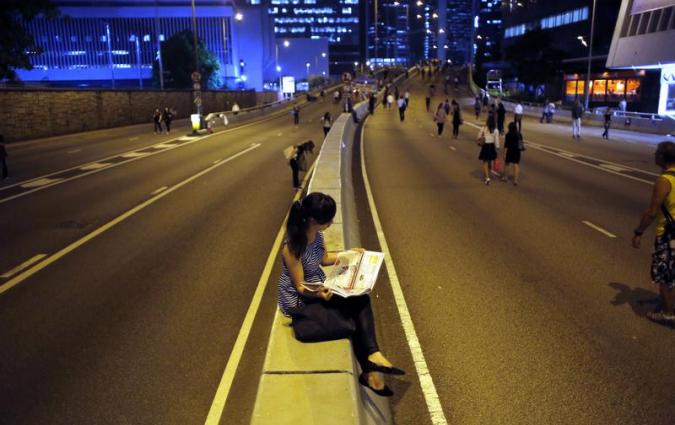In this piece
Women and leadership in the news media 2021: evidence from 12 markets

Pamella Makotsi Sittoni from 'Daily Nation', Encarna Samitier from '20 minutos', Nwabisa Makunga from 'The Sowetan' and Katharine Viner from 'The Guardian'.
In this piece
Key Findings ↑ | General Overview ↑ | Methods and Data ↑ | Findings ↑ | Conclusion ↑ | Footnotes | References ↑ | Acknowledgements ↑ | About the Authors ↑DOI: 10.60625/risj-k9c6-de85
Key Findings ↑
In this Reuters Institute’s factsheet we analyse the gender breakdown of top editors in a strategic sample of 240 major online and offline news outlets in 12 different markets across four continents.
Looking at a sample of 10 top online news outlets and 10 top offline news outlets in each of these 12 markets, we find:
- Only 22% of the 180 top editors across the 240 brands covered are women, despite the fact that, on average, 40% of journalists in the 12 markets are women. Looking only at the 10 markets we covered in 2020 and again in 2021, 23% of top editors are women, the same percentage as last year.
- Looking exclusively at the 178 brands included both this year and last year, the percentage of women among the top editors has changed from 22% in 2020 to 24% in 2021. Among 37 new top editors across these brands, 16% of these are women. (There were 14% women among the outgoing top editors.)
- In 11 out of 12 markets, the majority of top editors are men, including countries like Brazil and Finland where women outnumber men among working journalists. (In South Africa, 62% of journalists and 60% of top editors in our sample are women.)
- The percentage of women in top editorial positions varies significantly from market to market. In Japan, as last year, none of the major news outlets in our sample has a woman as their top editor. In South Africa, a majority of the top editors are women.
- When we compare the percentage of women working in journalism with the percentage of women in top editorial positions, we find a positive correlation. Despite this, in 10 out of 12 markets, there are considerably more women working as journalists than there are women among the top editors.
- Looking more broadly at gender inequality in society and the percentage of women in top editorial positions, we find no meaningful correlation. Countries like Germany and South Korea that score well on the UN Gender Inequality Index have very few top female editors.
- There is a notable variation in the number of people who get news from outlets with a female top editor. The percentage of online news users in each market that say they get news from one or more major outlets with a woman as the top editor (whether offline or online) ranges from a high of 94% in Kenya to 0% in Japan (where none of the major news outlets in our sample has a woman as their top editor).
General Overview ↑
Top editorial positions in major news outlets matter at both practical and symbolic levels. This has always been true, and the importance of this is only further underlined by the increasing focus on how news media often struggle with issues raised by social movements such as Black Lives Matter and #MeToo and calls to rethink imperial legacies. There is a concern that the media can sometimes miss relevant stories related to these issues, in part because top editors experience and see the underlying concerns very differently from those most directly affected by them.
Top editors are important as they are key figures leading newsroom direction and decision-making, shaping what news and newsrooms look like (Griffin 2014). They also play a role in the relationship between journalists and audiences (Duffy 2019). They represent their outlets and, therefore, who they are matters for how specific news outlets are seen by audiences and for how the news media more generally are perceived by society. One of the aspects of who top editors are that matters both practically and symbolically is their gender. For example, some scholars have pointed to the differences in news coverage which may emerge when newsrooms are run by women versus men (Beam and Di Cicco 2010; Byerly and McGraw 2020; Shor et al. 2015). That is why we in 2020 started mapping the gender of top editors at a sample of major outlets across a range of markets (Andı et al. 2020). We continue that work here.
Our analysis complements important research conducted by others working on the status of women in the news media, including the projects we highlighted last year by professional groups (e.g. the Global Media Monitoring Project’s Who Makes the News? report (most recently, Macharia 2015), a 2011 report by the International Women’s Media Foundation (Byerly 2011), a 2020 report from Luba Kassova on the missing perspectives of women in news, and nationally focused research, for example, from the American Society of News Editors Newsroom Diversity Survey, the Women’s Media Center, and work by Women in Journalism in the UK), as well as work by a range of academics (e.g. Harbert 2020; Lück et al. 2020; Topić and Bruegmann 2021).
Methods and Data ↑
Building on and extending our work from 2020 (Andı et al. 2020), we examine a strategic sample of 12 markets with varying levels of gender equality, as measured by the UN Gender Inequality Index. We include the same 10 markets we covered last year, as well as two new countries we did not cover in 2020, namely Kenya and Spain. To get an overview of global differences and similarities, we include a diverse selection of markets from multiple continents. To be able to leverage available data on the journalistic profession and on news and media use, we picked the 12 markets from those covered in Worlds of Journalism (Hanitzsch et al. 2019) and in the Reuters Institute Digital News Report 2020 (Newman et al. 2020). The 12 markets included in the sample are Kenya and South Africa in Africa; Hong Kong, Japan, and South Korea in Asia; Finland, Germany, Spain, and the United Kingdom in Europe; Mexico and the United States in North America; and Brazil in South America.
Apart from adding Kenya and Spain, our approach is identical to last year. In each market, we focused on the top 10 offline (TV, print and radio) and online news brands in terms weekly usage, as measured in the Reuters Institute Digital News Report 2020 (Newman et al. 2020). Our focus on the most widely used offline and online brands means that some important outlets with more limited reach are not included in the sample (in Hong Kong, for example, the South China Morning Post, which has a female editor-in- chief, is not in the sample). Because of changes in what the most widely used brands are, and our focus on the top 10 offline and online brands, there has been some turnover in the specific brands included in the analysis: 178 of the 200 brands covered in 2020 are included in the analysis again this year, 22 new brands are included from the 10 markets covered last year, and 40 brands from the two additional countries are included for the first time in 2021.
For each brand, we identified the top editor by checking their official webpages. The data were collected in February 2021. We looked for editor-in-chief or nearest equivalent, e.g. executive editor, head of news for TV. The exact terminology varies from country to country and organisation to organisation, but in most cases it is possible to identify a single person. We refer to the individuals identified collectively as the top editors. It is important to note that this of course does not imply that the top editor is the only person who matters, or even is always, in fact, the most important person in terms of day-to-day editorial decision-making. (As Director General, Tim Davie is both the Chief Executive Officer of the BBC and its Editor-in-Chief both offline and online. So here he is coded as the top editor for BBC both offline and online, even though Fran Unsworth serves as Director, News and Current Affairs.)
The individuals identified were double-checked by journalists from the market in question who have been Journalist Fellows at the Reuters Institute, as well by academic partners and our researchers. We also contacted the brands or their press offices to confirm who is their top editor. Where organisations responded, we always deferred to their judgement. In some cases where an organisation has not responded to our query, and where there is no single clear designated editor-in-chief, or roles and responsibilities across online and offline parts of the same outlet are unclear, we have made a judgement call as to who to code as the top editor of the outlet in question. As far as we are able to ascertain, every editor in the sample can be identified as either a woman or a man. We coded observations as missing in cases where both online and offline versions of the same brand share a top editor. In 2021, the analysis covers a total of 180 individuals across the 240 brands included, compared to 162 across the 200 brands we covered in 2020. Some top editors, such as Martin Baron, Executive Editor of the Washington Post, were stepping down at or around the time of data collection. We include here the top editor as of late February.
Findings ↑
Based on this dataset, we find that 22% of the 180 top editors across the 240 brands covered are women. On average, this is substantially below the 40% of journalists in the 12 markets who are women. Looking only at the 10 markets we covered in 2020 and again in 2021, 23% of top editors are women, the same percentage as last year.
Looking exclusively at the 178 brands we covered last year that are included again this year, there has been some turnover in top editorial positions, but how much varies greatly from market to market. In six markets, there are just one or two new top editors among the brands covered in both 2020 and 2021, while a few other markets have seen greater turnover, especially Hong Kong and South Korea. Looking exclusively at these 178 brands, in 2020, 22% of the top editors were women. In 2021, there are 37 new top editors among these brands, and 16% of these are women. (There were 14% women among those outgoing.)
Despite the increasing industry focus on lack of diversity in the news media, we find no clear overall trend towards greater gender equality in top editorial positions over the last year.
As is clear from Figure 1, the percentage of women in top editorial positions continues to vary significantly across the 12 markets we cover. In Japan, as was the case last year, none of the outlets covered has a female top editor. In South Africa, 60% of top editors in our sample are women, up from 47% last year. In the 11 other markets apart from South Africa, the majority of top editors are men (though the United States nears parity). Comparing 2020 and 2021 data from the 10 markets we covered both last year and this year, we can see that, while several markets have seen a growing share of women among top editors (South Korea, the US, South Africa), several others have seen declines (most notably Brazil, Germany and Finland).
Figure 1
Figure 2
When looking at the relationship between the number of women working in journalism and the percentage of women in top editorial positions shown in Figure 2, relying on data from Worlds of Journalism (Hanitzsch et al. 2019),1 like last year, we find a positive correlation. As we have noted before, correlation does not necessarily entail causation. But it is worth noting that markets with more women working in journalism also have more women in top editorial positions. Despite this, in 10 out of 12 markets, there are considerably more women working as journalists than there are women among top editors. (The United States and South Africa remain the only exceptions to this.)
If we look at the percentage of women in top editorial positions in the context of data on gender inequality in society more broadly, relying on data from the UN Gender Inequality Index (2020), we find no clear interpretable pattern across 11 markets (Hong Kong is not included in the UN Gender Inequality Index), as shown in Figure 3.
Figure 3
The absence of a positive correlation is, in itself, interesting. As we noted last year, journalism clearly has its own internal dynamics influencing career paths and the gender composition of top editorial ranks. Countries like Germany and South Korea – and in the most extreme case Japan – illustrate that higher gender equality, as measured by the UN Gender Inequality Index, does not in itself mean more women in top editorial positions.
Finally, by combining the data collected for this Reuters Institute factsheet with data from the Reuters Institute Digital News Report 2020 (Newman et al. 2020), we can establish the proportion of people in each of the 12 markets covered who access news from at least one major news outlet with a woman as the top editor, shown in Figure 4.
As can be seen in Figure 4, the share of online news consumers who say that they read news from at least one major outlet with a female top editor ranges from 94% in Kenya to 0% in Japan. In half the markets covered, less than half of internet news users have accessed news from at least one major outlet with a female top editor in the past week. The average across all markets covered is unchanged from last year.
Figure 4
Conclusion ↑
In this Reuters Institute’s factsheet we have analysed the gender breakdown of top editors at a strategic sample of 240 major online and offline news outlets in 12 different markets across four continents. We have found that the clear majority of top editors across the sample are men, and only one market covered has a majority of women among top editors. While there is a positive correlation between the percentage of women working as journalists and the percentage of women among top editors, there is a lower proportion of women in top roles than women in the profession as a whole. This is in line with years of research documenting vertical segregation in the news industry (e.g. Franks 2013). We find no clear interpretable relationship between overall gender equality in society and the percentage of women among top editors, underlining that there are specific dynamics at play in journalism and the news media.
Whilst the last year has seen an increasing reckoning with the frequent lack of diversity in newsrooms, especially in top positions, we find no clear overall trend towards greater gender equality in top editorial positions from 2020 to 2021. While there are more women (16%) among the 37 new names in our dataset than among those who held the same posts last year (14%), the number is still comparatively low.
So despite greater focus on diversity, we find no significant evidence of change. This, of course, often takes time, and with the severe impact of the coronavirus pandemic, lockdowns and among many other things a consequent wave of layoffs at many news media, the past year has been unusual and unusually demanding in many ways. Perhaps there is more to come? Several important news brands will be appointing new top editors in the year ahead, many journalists are pushing for more diverse leadership, and some news media are publicly recognising how they have fallen short on diversity for a long time. We will know more about how this might change the overall profile when we repeat this analysis in 2022 to track developments in gender equality among top editors across the world.
Footnotes
1The data from Worlds of Journalism (Hanitzsch et al. 2019) used in this analysis were collected between 2012 and 2016..
References ↑
- Andı, S., Selva, M., Nielsen, R. K. 2020. Women and Leadership in the News Media 2020: Evidence from Ten Markets. Oxford: Reuters Institute for the Study of Journalism.
- Beam, R. A., Di Cicco, D. T. 2010. ‘When Women Run the Newsroom: Management Change, Gender, and the News’, Journalism and Mass Communication Quarterly 87, 393–411.
- Byerly, C. M. 2011. Global Report on the Status of Women in the News Media. Washington DC: International Women’s Media Foundation.
- Byerly, C. M., McGraw, K. A. 2020. ‘Axes of Power: Examining Women’s Access to Leadership Positions in the News Media’, in M. Djerf-Pierre and M. Edström (eds), Comparing Gender and Media Equality across the Globe: A Cross-National Study of the Qualities, Causes, and Consequences of Gender Equality in and through the News Media. Gothenburg: Nordicom, University of Gothenburg, 191–232.
- Clark, M. D. 2019. ‘ASNE Newsroom Diversity Survey’, News Leaders Association.
(accessed Feb. 2021). - Darrah, K., and Haddou, L. 2020. ‘A Week in British News: How Diverse are the UK’s Newsrooms?’, Women in Journalism (accessed Feb. 2021).
- Duffy, A. 2019. ‘Out of the Shadows: The Editor as a Defining Characteristic of Journalism’, Journalism.
- Franks, S. 2013. Women and Journalism. Oxford: Reuters Institute for the Study of Journalism.
- Griffin, A. 2014. ‘Where are the Women? Why we Need More Female Newsroom Leaders’, Nieman Reports. (accessed Feb. 2021).
- Hanitzsch, T., Hanusch, F., Ramaprasad, J., de Beer, A. S., (eds). 2019. Worlds of Journalism: Journalistic Cultures around the Globe. New York: Columbia University Press.
- Harbert, L. E. 2020. ‘Hear their Voices: A Qualitative Study of Women Leaders in Public Media’, Journal of Radio and Audio Media 27, 119–33.
- Kassova, L. 2020. The Missing Perspectives of Women in News. (accessed Feb. 2021).
- Lück, J., Schultz, T., Simon, F., Borchardt, A., Kieslich, S. 2020. ‘Diversity in British, Swedish, and German Newsrooms: Problem Awareness, Measures, and Achievements’, Journalism Practice 1–21.
- Macharia, L. 2015. ‘Who Makes the News?’ Global Media Monitoring Project, 1–149, (accessed Feb. 2021).
- Newman, N., Fletcher, R., Schulz, A., Andı, S., Nielsen R. K. 2020. Digital News Report 2020. Oxford: Reuters Institute for the Study of Journalism.
- Shor, E., van de Rijt, A., Miltsov, A., Kulkarni, V., Skiena, S. 2015. ‘A Paper Ceiling: Explaining the Persistent Underrepresentation of Women in Printed News’, American Sociological Review 80, 960–84.
- Topić, M., Bruegmann, C. 2021. ‘“The Girls at the Desk”: Timeless Blokishness in the Newsroom Culture in the British Press?’, Journalism Studies 22, 77–95.
- United Nations Development Programme. 2020. ‘Gender Inequality Index’, Human Development Reports. New York: UNDP. (accessed Feb. 2021).
- Women’s Media Center. 2019. ‘The Status of Women in the U.S. Media 2019', (accessed Feb. 2021).
Acknowledgements ↑
The authors would like to thank Sangmee An, Simge Andı, Michael Chan, Styli Charalambous, Juliana Fregoso, Jenni Kangasniemi, Francis Lee, Grace Leung, Adele Machado Santelli, Caithlin Mercer, Camila Mont’Alverne, Nic Newman, Verah Okeyo, Khadija Patel, Yasuomi Sawa, Anne Schulz, Eduardo Suárez, Luiz Fernando Toledo Antunes, and Emily Tsang for their valuable time, input, and feedback.
About the Authors ↑
Craig T. Robertson is a Research Fellow at the Reuters Institute for the Study of Journalism.
Meera Selva is Deputy Director and Director of the Journalist Fellowship Programme at the Reuters Institute for the Study of Journalism.
Rasmus Kleis Nielsen is Director of the Reuters Institute for the Study of Journalism and Professor of Political Communication at the University of Oxford.
Published by the Reuters Institute for the Study of Journalism.

This report can be reproduced under the Creative Commons licence CC BY. For more information please go to this link.




